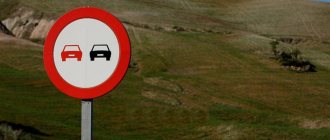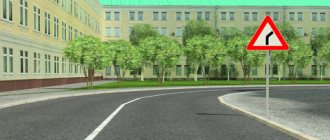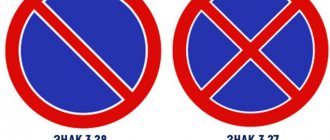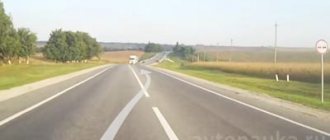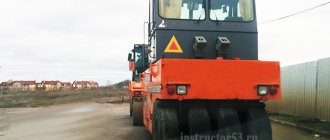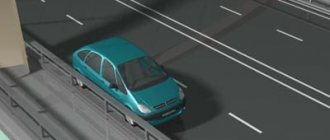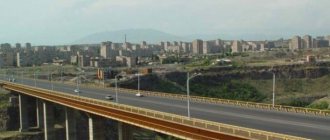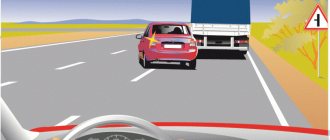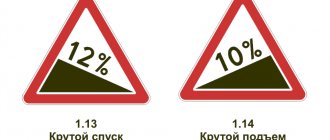Are you required to turn on your turn signals in this situation?
| 1. | Yes, but only if there are other vehicles at the intersection. |
| 2. | Yes. |
| 3. | No. |
At this intersection, following the “Move to the right” sign, you can continue moving only to the right. In this case, you must turn on the right turn signal lights corresponding to this maneuver.
Avoiding an obstacle through a solid road: who performs the maneuver and how, signs
Crossing a solid marking line in any case is a violation, and therefore, even when driving around an obstacle, the traffic police inspector will issue a fine to the driver. The only option to avoid punishment is to make a detour through a continuous road when there are road signs indicating permission to perform the maneuver or in the presence of a traffic police officer.
Avoiding an accident through a clear road
According to the rules, emergency vehicles must be removed from the road as much as possible and not interfere with the movement of other vehicles. But this is only possible after the traffic police have drawn up a protocol. This results in a legal contradiction, but this does not give the right to bypass the obstacle through a solid line - you will need to either wait until the highway is cleared, or strictly follow the instructions of the traffic controller, or subsequently pay a fine.
Avoiding obstacles on the left and right
When choosing whether to detour on the right or on the left, you should choose the first option. If there is a fence or any other obstacle to the right of the obstacle, then there is simply no choice left.
Many drivers do not pass on the right because there is a lawn there. But this is the “lesser evil”, if we take the punishment under the traffic rules as a basis - there is no definition of a lawn in the statute at all, it will be extremely difficult for the traffic police inspector to prove a violation, which will help to avoid penalties.
Sign to avoid obstacles on the right or left
A detour sign looks like a circle with a blue background and a white arrow on it indicating the detour direction (left or right).
If such a sign is posted for an accident, and the arrow indicates the possibility of making a detour on the left, then the presence of solid median strips can be ignored. The driver will have to return to his lane as soon as the obstacle no longer interferes with such a maneuver.
Road sign “Avoid obstacles on the right”
If the sign indicates the possibility of independently choosing a detour, then it is recommended to take it on the right - and the traffic rules for crossing a solid line will not be violated, and the likelihood of an accident in the oncoming lane will be reduced to the possible minimum.
Avoiding an obstacle at an intersection
Avoiding an obstacle at an intersection follows the general rules. If a driver drives into the oncoming lane, this is regarded by employees as a traffic violation. You can avoid punishment only by waiting until the obstacle is cleared from the roadway.
Avoiding obstacles on the side of the road
Driving around an obstacle on the side of the road is permitted by traffic rules; the inspector does not have the right to fine the driver. But you need to remember that the traffic police officer will have to prove that it was a detour and not an overtaking. And then, you need to understand the term “obstacle” - a traffic jam is not considered such.
More on AutoLex.Net:
What does the “Water Protection Zone” sign indicate, travel rules, installation according to GOST
How to move through a double solid line
It is strictly forbidden to move through a double continuous line, even if there is an obstacle in your lane. In case of violation, three types of punishment may follow:
- a fine of 5,500 rubles - if the driver did not enter the oncoming lane, but crossed a double solid line due to the need to take a detour;
- a fine of 1000-1500 rubles - if the driver crossed a double continuous line while driving around, which separates traffic flows in two different directions;
- deprivation of a driver's license for 4-6 months or a fine of 5,000 rubles - if crossing a solid double marking line was not made for the purpose of avoiding an obstacle.
Watch this video about the rules for passing through a solid marking line:
What trajectory can you continue moving along?
| 1. | Only according to A. |
| 2. | Only according to B. |
| 3. | For any reason. |
At this intersection, the road being crossed has three carriageways. The “Move to the right” sign applies only to the first intersection of roadways in front of which it is installed, ordering all vehicles to turn right onto the first roadway, i.e. only along trajectory A.
Penalties for non-compliance
Violation of the requirements of prohibitory and prescriptive signs will entail administrative measures for the offender. Their type depends not only on the fact of the violation itself, but also on the severity of the consequences.
For example, if a traffic participant performed a maneuver in violation and found himself in the oncoming lane or within the boundaries of a pedestrian zone, he could cause damage to the property, health or life of others. In such cases, not only administrative, but also criminal liability may arise.
The sanctions applied to violators are specified in Article 12.16 of the Code of Administrative Offenses of the Russian Federation. In such cases, a fine of 500 rubles will be imposed on the perpetrator. If such a maneuver was accompanied by driving into the oncoming lane, the fine will increase to 5 thousand rubles, and the driver will be deprived of his license for up to six months. In case of repeated violation, the period of deprivation of rights will be twelve months.
| Did not find an answer to your question? Call a lawyer! Moscow: +7 (499) 110-89-42 St. Petersburg: +7 (812) 385-56-34 Russia: +7 (499) 755-96-84 |
A driver who does not comply with the rules of the maneuver may fall under Article 12.15 of the Code of Administrative Offenses of the Russian Federation. In this case, he faces a fine in the amount of one to one and a half thousand rubles.
You are allowed to continue driving:
| 1. | Only along trajectory A. |
| 2. | Only along trajectory B. |
| 3. | Along trajectories A and B. |
| 4. | Along trajectories B and C. |
| 5. | Along any trajectory from those indicated. |
You can continue moving only along trajectory B, since by turning along trajectory A, you will not comply with the requirement to move as close as possible to the right edge of the roadway, and continuing further movement along the lane for route vehicles along trajectory B is prohibited.
What is an obstacle in traffic rules?
The traffic rules, paragraph 1.2, clearly indicate the definition of an obstacle:
“Obstacle” is a stationary object in the traffic lane (faulty or damaged vehicle, roadway defect, foreign objects, etc.) that does not allow further movement along this lane.
We can conclude that a pothole, shards of glass/car parts after an accident, a bus at a stop, a puddle, a traffic jam and even a careless pedestrian are not considered an obstacle - avoiding these obstacles by traffic police inspectors will be regarded as a violation of traffic rules.
What is an obstacle on the road according to traffic regulations?
Obstacles on the road according to traffic rules are:
- fences erected in connection with ongoing road works;
- hole or dip in the road;
- a fallen tree, a piece of concrete slab, house walls and other large objects;
- a vehicle with a warning triangle displayed.
Foreign objects on the roadway: what applies to them
Foreign objects on the roadway may include:
- carcasses of large animals;
- a sofa, refrigerator or any other large load that has fallen from the car;
- big Stone;
- large snowdrift.
Definition of an insurmountable obstacle
The Road Traffic Rules do not specify the concept of “insurmountable obstacle” at all. Therefore, any stationary object that cannot be avoided either in the oncoming lane or on the side of the road can be considered as such. Here's what a driver should do in this case:
- wait until an insurmountable obstacle is removed from the road;
- make a U-turn, unless prohibited by rules/signs, and move in the opposite direction.
Rules for avoiding obstacles on the road
Rules for avoiding obstacles on the road are classic:
- you need to stop in front of the obstacle (at least 3 meters);
- wait for the entire flow of vehicles to pass in the oncoming lane;
- turn on the left turn sign;
- make a detour and immediately return to your lane.
More on AutoLex.Net:
Basic rights and responsibilities of the driver of various vehicles
These rules apply only if an obstacle arises on the route along a two-lane highway.
Watch this video about the rules for avoiding obstacles on the road:
Which vehicles are only allowed to proceed to the right?
| 1. | Vehicles with a permissible maximum weight of more than 10 tons. |
| 2. | Only for vehicles carrying cargo weighing more than 10 tons. |
| 3. | Only for vehicles with an actual weight of more than 10 tons. |
Under the sign 4.1.2 “Move to the right” there is a plate 8.11 “Limitation of the permissible maximum weight”, which indicates that the sign applies to vehicles with a permissible weight of more than 10 tons, which must turn right.
What is a detour?
Unfortunately, the current traffic rules do not decipher the concept of detour, so you should refer to Article 12.15 of the Code of Administrative Offenses.
Based on Part 3 of Article 12.15 of the Administrative Code, as well as on the basis of paragraphs 9.2 and 15.3 of the traffic rules, we can conclude that a detour is a kind of maneuver associated with leaving the occupied lane if further movement along the original lane is impossible:
9.2. On dual carriageway roads with four or more lanes, it is prohibited to overtake or pass into the lane intended for oncoming traffic. On such roads, left turns or U-turns may be made at intersections and in other places where this is not prohibited by the Rules, signs and (or) markings.
15.3. It is forbidden to travel to move: ...
- drive around vehicles standing in front of the crossing into oncoming traffic;
Thus, if a vehicle makes a lane change due to the fact that the lane is blocked by something or someone, then its maneuver can be considered as a detour. In all other cases, i.e. if there is some activity in the lane in the form of a moving vehicle, the maneuver can be considered as overtaking or overtaking.
Please note that the penalty for illegal overtaking is more severe than the penalty for illegal passing.
